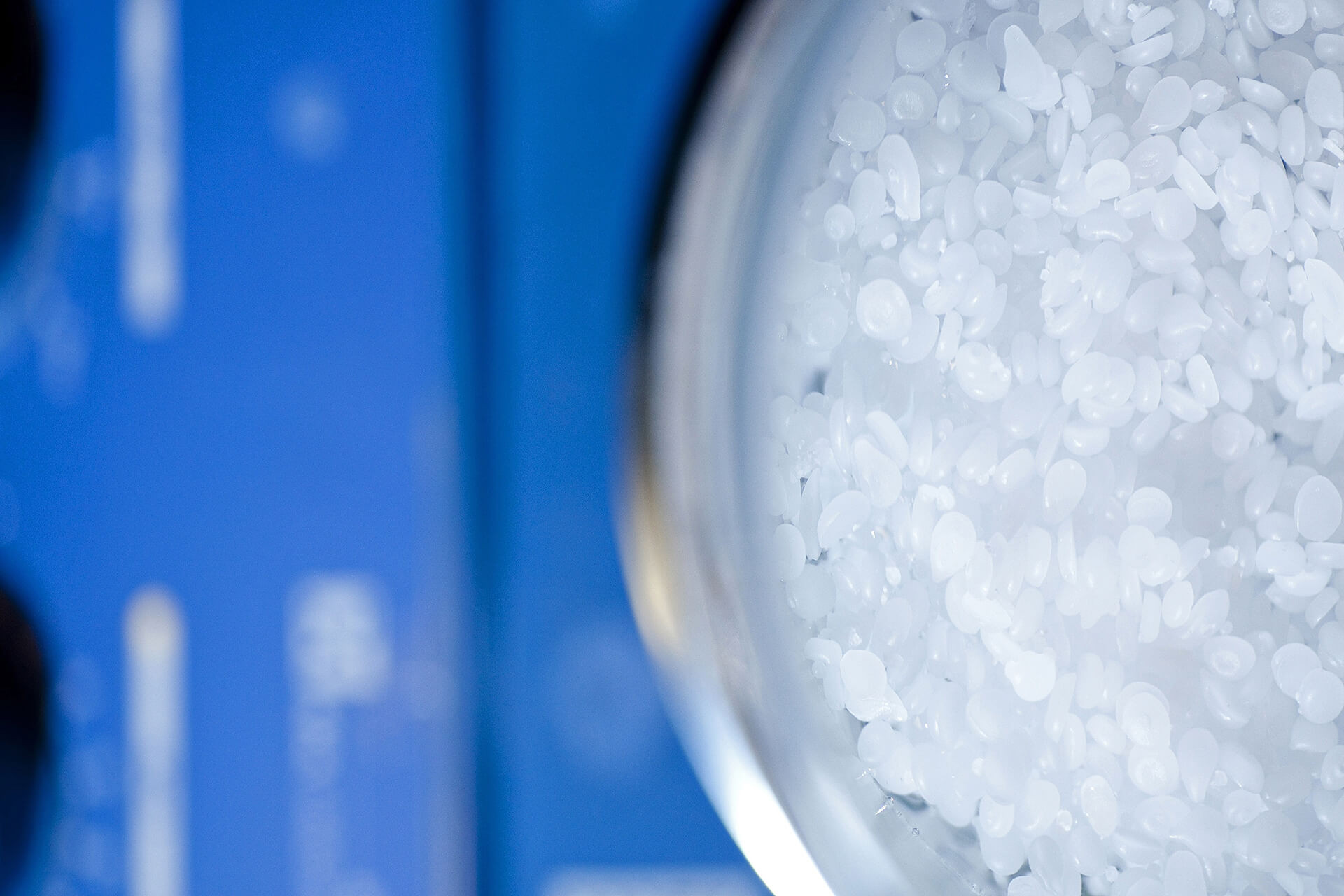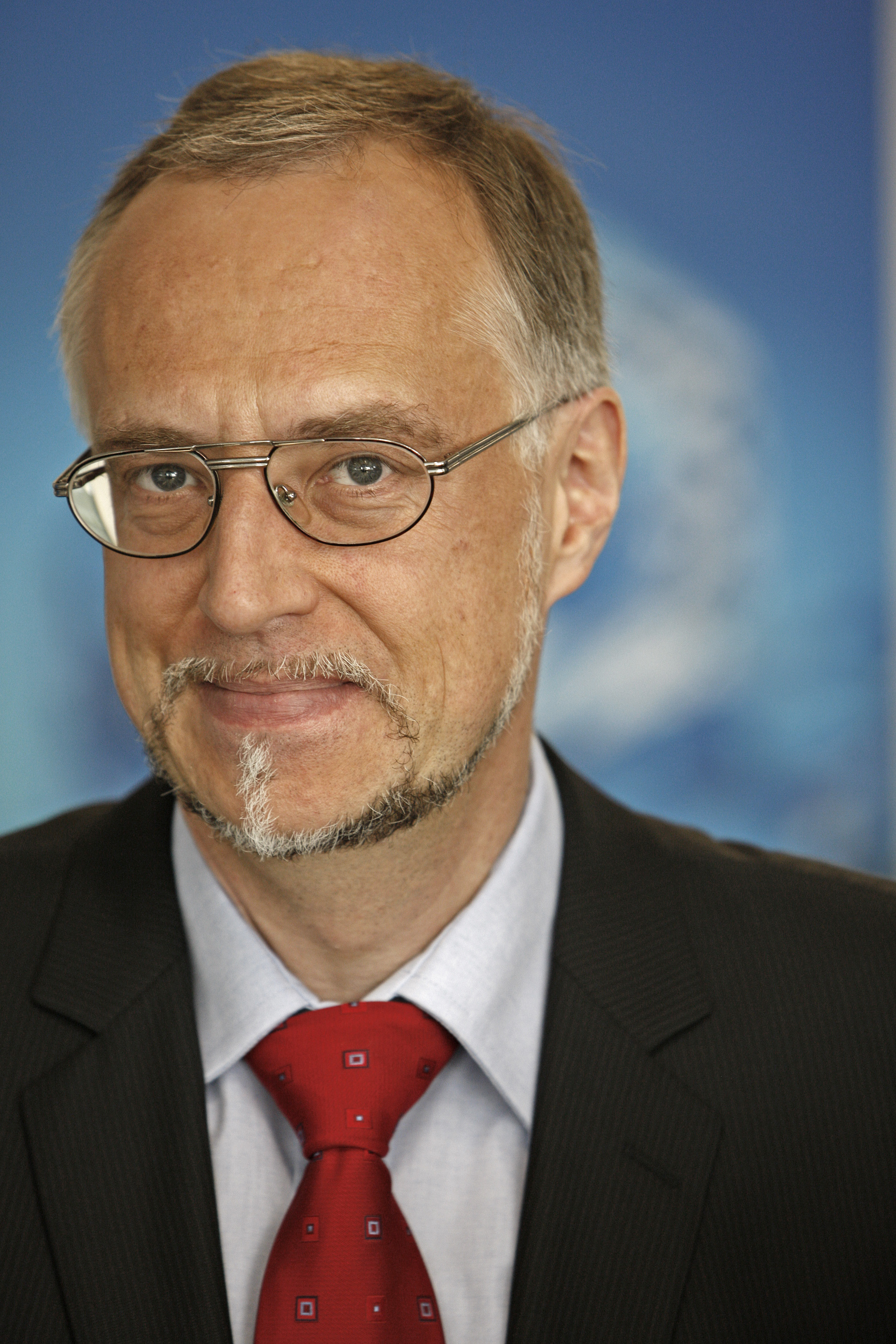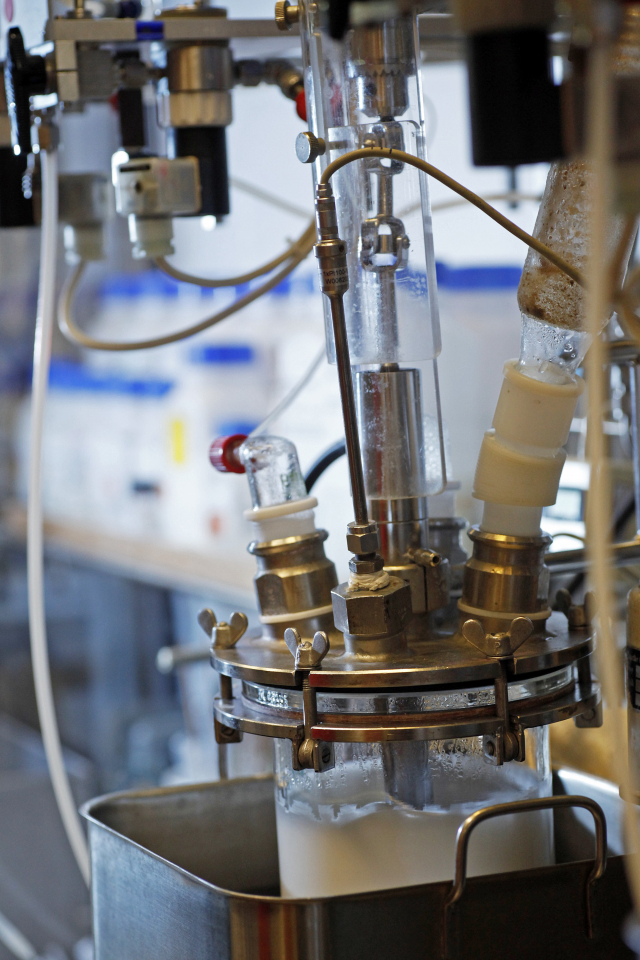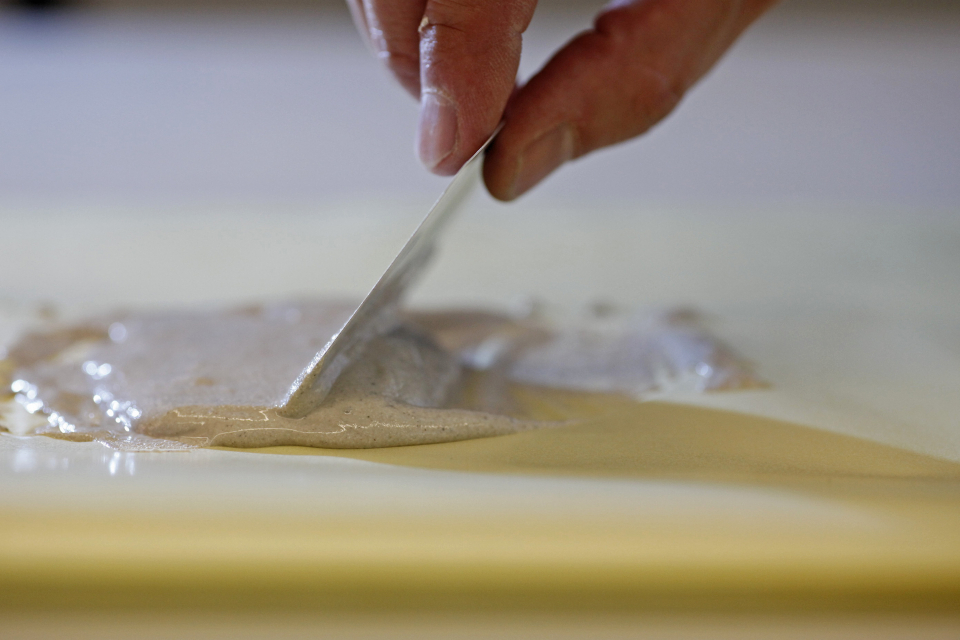
Nominee 2009
Kugeln gegen Klimawandel

Prof. Dr. Volker Wittwer, Dr. Ekkehard Jahns and Dr. Peter Schossig have found a way to improve the quality of indoor comfort while keeping energy consumption to a minimum and protecting the environment. Volker Wittwer was the founding member of the Fraunhofer Institute for Solar Energy Systems ISE – the largest European solar research institute – and until mid-year was also its deputy director. Ekkehard Jahns is manager for global product development of polymers for architectural coatings at BASF SE. He has contributed many years of experience in microencapsulation to the project. Peter Schossig has been active in the area of thermal energy use since 1995 and has headed the group “Thermally active materials and solar cooling” at ISE since 2005.

The basis for the innovation developed by the three research scientists are latent heat storage materials or phase change materials (PCM). Use of these materials is based on physics: During the transition from a solid to a liquid state, a PCM absorbs vast amounts of energy from its environment without heating up itself. The absorbed heat is “hidden” inside.
more details
Resumes

Prof. Dr. rer. nat. Volker Wittwer
- 25.06.1944
- geboren in Garching/Alz
- 1964
- Abitur
- 1964 – 1966
- Ausbildung zum Reserveoffizier bei der Bundeswehr
- 1966 – 1971
- Studium der Physik, Technische Universität München
- 1971 – 1974
- Promotion, Physik Department, Technische Universität München (TUM), Thema: Untersuchung flacher Haftstellen in ZnO-Einkristallen mittels Infrarotstimulation bei tiefen Temperaturen
- 1974
- Wissenschaftlicher Mitarbeiter am Fraunhofer-Institut für Angewandte Festkörperphysik IAF, Freiburg im Bereich Displayphysik
- 1981
- Gründungsmitglied des Fraunhofer-Institutes für Solare Energiesysteme ISE, Freiburg
- 1981
- Abteilungsleiter Thermische Systeme, Fraunhofer-Institut für Solare Energiesysteme ISE, Freiburg
- 1993
- Habilitation im Bereich Physik, Carl von Ossietzky Universität Oldenburg, Oldenburg
- 1993
- Abteilungsleiter Thermische und Optische Systeme, Fraunhofer-Institut für Solare Energiesysteme ISE, Freiburg
- 1997 – 2009
- Stellvertretender Institutsleiter , Fraunhofer-Institut für Solare Energiesysteme ISE, Freiburg
- 2001
- Umhabilitation, Fakultät für Angewandte Wissenschaften, Albert-Ludwigs-Universität, Freiburg
- 2007
- Außerplanmäßiger Professor, Fakultät für Angewandte Wissenschaften, Albert-Ludwigs-Universität, Freiburg
Ehrungen:
- 2006
- Solar Heating and Cooling Award der Internationalen Energie Agentur (IEA), Paris
Weitere Tätigkeiten:
- Organisation zahlreicher internationaler Tagungen im Bereich Sonnenenergie und Materialforschung (SPIE, ISES)
- Mitglied der Deutschen Physikalischen Gesellschaft DPG
- Mitglied der Internationalen Gesellschaft für Solarenergie ISES
- Mitglied im Verein Deutscher Ingenieure VDI

Dr. rer. nat. Ekkehard Jahns
- 28.05.1959
- geboren in Bremen
- 1979
- Abitur
- 1980 – 1984
- Studium der Chemie, Technischen Universität Clausthal
- 1984
- Diplom
- 1989
- Promotion, Fakultät für Chemie, Pharmazie, Albrecht-Ludwigs-Universität Freiburg i. Br., Thema: "Synthese, Rheologie und Kerr-Effekt-Messungen an niedermolekularen und polymeren Amphiphilen“
- 1989 – 2005
- Laborleiter, Kunststofflaboratorium, BASF AG, Ludwigshafen:
- Mikroverkapselung für kohlefreie Durchschreibepapiere und Entwicklung von thermotropen Polymerblends
- Seit 1997: PCM-Mikrokapseln zur passiven Gebäudekühlung, PCM-Slurries und Textilanwendungen
- Seit 2005
- Projektleiter Bindemittel “Architectural Coatings“ BASF SE, Ludwigshafen
Ehrungen:
- 2001
- BASF Innovationspreis

Dr.-Ing. Peter Schossig
- 17.08.1970
- geboren in Basel, Schweiz
- 1990
- Abitur
- 1990
- Studium der Physik an der Albert-Ludwigs-Universität Freiburg, Freiburg
- 1998
- Diplom
- seit 1998
- Wissenschaftlicher Mitarbeiter, Fraunhofer-Institut für Solare Energiesysteme ISE, Freiburg
- 2005
- Promotion, Fakultät für Architektur, Fachgebiet für Bauphysik und Technischer Ausbau, Universität Karlsruhe (TH), Karlsruhe, Thema „Mikroverkapselte Phasenwechselmaterialien in Wandverbundsystemen“
Contact
Spokesperson
Prof. Dr. rer. nat. Volker Wittwer
Berater der Institutsleitung, Fraunhofer ISE
Fraunhofer Institut für Solare Energiesysteme ISE
Heidenhofstraße 2
79110 Freiburg
Tel.: +49 (0) 761 / 74 58 85 140
Fax: +49 (0) 761 / 74 58 89 116
E-Mail: volker.wittwer@ise.fraunhofer.de
Web: www.ise.fraunhofer.de
Press
Karin Schneider
Leiterin Presse und Public Relations
Fraunhofer Institut für Solare Energiesysteme ISE
Heidenhofstraße 2
79110 Freiburg
Tel.: +49 (0) 761 / 45 88 51 47
Fax: +49 (0) 761 / 45 88 91 47
E-Mail: Karin.Schneider@ise.fraunhofer.de
Web: www.ise.fraunhofer.de
Agata Koziuk
Communications Dispersions for Adhesives and Construction Europe
BASF SE
ED/K - H201
67056 Ludwigshafen
Tel.: +49 (0) 621 / 60 49 181
Fax: +49 (0) 621 / 60 66 49 181
E-Mail: agata.koziuk@basf.com
Web: www.basf.com
A description provided by the institutes and companies regarding their nominated projects
Energy efficiency has become very important in conjunction with climate change and political objectives on reducing CO2 emissions. Studies prove that over 60 million tons of CO2 can be saved in Germany through sustainable construction and renovation. This potential is in opposition to the increasing use of air-conditioning systems in buildings. One alternative to energy-intensive space cooling is afforded by Micronal® PCM from BASF – a microencapsulated latent heat storage material.
An Intelligent Building System
Both when building a new structure as well as during renovations, buildings can be made energy efficient above all by adopting coordinated measures. In winter, this includes good insulation as well as state-of-the-art heating systems. Darkening windows as well as nighttime ventilation protect the indoor environment from heat in summer. Innovative building materials with integrated latent heat storage materials – also referred to as PCM (phase change material) – can also slow a rapid increase in temperature or even stop it. These intelligent materials store the cooler night temperatures and thus provide indoor climate temperatures well within the comfort zone without using electricity or requiring any maintenance.
The ice cube effect
Decisive for the action of the latent heat storage material is the physical phenomenon at the point where the substance changes from a solid to a liquid state. During this phase change, a great deal of heat energy is absorbed without changing the temperature of the material. The amount of energy that a material transfers during the transition from one phase to another – for example, from ice into water – is thus referred to as hidden or latent heat. During the change, for example, the melting ice cube absorbs vast amounts of heat from the surrounding liquid and keeps the beverage pleasantly cool even in summer. Just how great this effect is, is illustrated in the following comparison: the same amount of energy is needed to melt one kilo of ice that is needed to heat one liter of water from 0°C to 80°C.
The right packaging
Scientists have already been researching the positive effect of latent heat storage materials for buildings since the middle of the past century. One idea consisted of simply soaking building materials with latent heat storers. However, since they melt when they absorb heat and run, this approach was unsuccessful. In later attempts, latent heat storers were packed in spheres the size of tennis balls or in bags. The size presented numerous problems in the use of PCM. They are very susceptible to mechanical damage. Moreover, the exchange of heat with the environment is limited, specifically during regeneration, meaning the solidification of the material. Thus, widespread use of latent heat storers was defeated primarily due to a lack of a suitable package.
Cooperation of science and industry
As small and as retentive as possible – the solution to the packing problem for latent heat storage materials was discovered by the Fraunhofer Institute for Solar Energy Systems (ISE). The institute found the right partner in BASF to implement their idea. The chemical company identified paraffin wax as the suitable latent heat storer and developed a special microencapsulation technology. While BASF optimized the process in the laboratory and applied it to an industrial scale, ISE studied the thermal output of the capsules and used simulation to calculate the specific requirements for the best-possible action of the material in buildings. The product invented by ISE and developed by BASF can now easily be used in an industrial scale in latent heat storers in virtually every known building material, such as mortars, plaster or wood.
Microencapsulated heat storage
Micronal PCM consists of minute drops of wax encased in acrylic glass. In diameter, they are five times smaller than a human hair which is why they can only be seen under a microscope. The capsules themselves are virtually indestructible because of the special casing and particle size of only a few micrometers. Building materials containing the BASF latent heat storers are easy to drill into or cut. Even if the capsules are damaged, only an insignificant amount of wax escapes. The microscopically small capsules have a very large surface area with which they exchange heat rapidly with the environment. The waxes used in Micronal PCM melt at temperatures between 21°C and 26°C depending on the application. In the process, they absorb vast amounts of heat from the environment and thus prevent the temperature from rising. At night, when the ambient temperature falls, the wax solidifies and the capsules release heat they have absorbed.
Efficient space cooling
The cooling effect of PCM products in modern buildings is largely equivalent to conventional building cooling systems. In the best case scenario, air conditioners can be switched off for most of the day or only run at night. In this way, the drafts and noise caused by these systems can be avoided – without sacrificing a comfortable indoor climate. In the best case, using PCM allows building owners to dispense with cooling systems entirely or they can be designed on a much smaller scale. Unlike an air-conditioning system, the material requires no maintenance. Building materials modified with Micronal PCM remain functional for decades. The Fraunhofer ISE has already thoroughly tested building materials made of Micronal PCM in stress tests and simulated a long-term use of 30 years. During testing, the latent heat storage material was heated and cooled around 10,000 times without affecting performance. Micronal PCM as a raw material and building materials that use it were thus awarded the RAL quality control association mark PCM.
Possible uses worldwide
Micronal PCM has already made the leap from laboratory to practical application in a wide variety of construction projects. Countries around the world have expressed interest in this environmentally compatible temperature management system with its conservative use of resources. Throughout Europe, Japan, Korea, Australia, Argentina and the USA, buildings are already being built and in use that are adapted to meet local climatic conditions. Micronal PCM can be used in a variety of ways – from new buildings to renovations to additions. Modern office buildings remain flexible thanks to interior conversions with PCM building materials without having to sacrifice a comfortable room temperature. They are thus superior to massive buildings whose interior walls are made of concrete or stone. Using PCM for renovations in schools, hospitals, or hotels can bring added comfort and lower power consumption.
Trends in Construction and Living
The climate targets formulated by the European Union for reducing CO2 emissions call for especially energy-efficient types of buildings and housing. Around 15 percent of the total demand for electricity throughout Europe is already used for indoor climate control and air-conditioning – and the trend is rising. Compared to the year 2000, the total building area to be cooled in Europe is expected to double by the year 2020. This steady increase is especially problematic since the majority of energy required for this purpose is concentrated in a few hours per day. This overloads the power grids and makes it more difficult to meet the energy requirement with alternative forms of energy. Unlike energy from power plants, power generation by regenerative energy sources cannot be controlled as needed. Consequently, buildings must close this time gap in future and be able to store CO2-free environmental energy temporarily. This is made possible by Micronal PCM as part of intelligent construction concepts – for modern, architecturally attractive and highly comfortable buildings.
About Fraunhofer ISE
The Fraunhofer Institute for Solar Energy Systems (ISE) in Freiburg is one of Europe’s largest solar research institutes, employing 880. The institute’s work ranges from the investigation of scientific and technological fundamentals for solar energy applications, through the development of prototypes, to the construction of demonstration systems. The focus is on energy-efficient and solar architecture, photovoltaics, solar thermal systems, and hydrogen technology. Another important focus is the consideration of existing energy savings potentials as well as the intelligent use of energies. Efficient conversion and storage technologies are playing an ever more important role in this area.
About BASF
BASF – The Chemical Company - is the world’s leading chemical company. The portfolio ranges from chemicals, plastics, and performance products to pesticides, fine chemicals, as well as oil and gas. As a reliable partner, BASF and their 97,000 employees help make their clients in virtually all branches more successful. With high-quality products and intelligent solutions, BASF helps find answers to global challenges, such as climate protection, energy efficiency, nutrition and mobility.
The right to nominate outstanding achievements for the Deutscher Zukunftspreis is incumbent on leading German institutions in Science and Industry as well as foundations.
The project “Small spheres against climate change – energy efficiency and comfort thanks to intelligent building materials” was nominated by the Fraunhofer Association.


 Gebärdensprache
Gebärdensprache
 Leichte Sprache
Leichte Sprache













